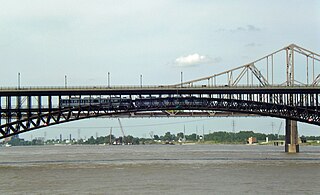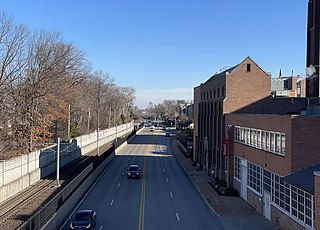
MetroLink is a light rail system that serves the Greater St. Louis area. Operated by Metro Transit in a shared fare system with MetroBus, the two-line, 38-station system runs from St. Louis Lambert International Airport and Shrewsbury in Missouri to Scott Air Force Base in Illinois. Intermediate destinations include downtown Clayton, Forest Park, and downtown St. Louis. It is the only U.S. light rail system to cross state lines.

The Monon Railroad, also known as the Chicago, Indianapolis, and Louisville Railway from 1897 to 1971, was an American railroad that operated almost entirely within the state of Indiana. The Monon was merged into the Louisville and Nashville Railroad in 1971, and much of the former Monon right of way is owned today by CSX Transportation. In 1970, it operated 540 miles (870 km) of road on 792 miles (1,275 km) of track; that year it reported 1320 million ton-miles of revenue freight and zero passenger-miles.

The SouthWest Service (SWS) is a Metra commuter rail line, running southwest from Union Station in downtown Chicago, Illinois, to Manhattan, Illinois. Metra does not refer to its lines by color, but the timetable accents for the SouthWest Service line are "Banner Blue," for the Wabash Railroad's Banner Blue passenger train. The trackage is owned by Metra north of a junction with the Belt Railway of Chicago at Loomis Boulevard, and is leased from Norfolk Southern Railway south of the junction.

The Illinois Terminal Railroad Company, known as the Illinois Traction System until 1937, was a heavy duty interurban electric railroad with extensive passenger and freight business in central and southern Illinois from 1896 to 1956. When Depression era Illinois Traction was in financial distress and had to reorganize, the Illinois Terminal name was adopted to reflect the line's primary money making role as a freight interchange link to major steam railroads at its terminal ends, Peoria, Danville, and St. Louis. Interurban passenger service slowly was reduced, ending in 1956. Freight operation continued but was hobbled by tight street running in some towns requiring very sharp radius turns. In 1956, ITC was absorbed by a consortium of connecting railroads.

Metro Transit is an enterprise of the Bi-State Development Agency and operates public transportation services in the St. Louis region. In 2022, the system served 19,049,100 passengers.

Delmar Loop station is a St. Louis MetroLink station. This station is adjacent to the Delmar Loop entertainment district that straddles St. Louis and St. Louis County. Nearby attractions include the restored Tivoli Theater as well as the Pageant concert venue along with the numerous restaurants and shops that line Delmar Boulevard. Directly adjacent to the stop is the North Campus of Washington University in St. Louis.

Transportation in Greater St. Louis, Missouri includes road, rail, ship, and air transportation modes connecting the bi-state St. Louis metropolitan area with surrounding communities throughout the Midwest, national transportation networks, and international locations. The Greater St. Louis region also supports a multi-modal transportation network that includes bus, paratransit, and light rail service in addition to shared-use paths, bike lanes and greenways.

TheNational Museum of Transportation (TNMOT) is a private, 42-acre transportation museum in the Kirkwood suburb of St. Louis, Missouri. Founded in 1944, it restores, preserves, and displays a wide variety of vehicles spanning 15 decades of American history: cars, boats, aircraft, and in particular, locomotives and railroad equipment from around the United States. The museum is also home to a research library of transportation-related memorabilia and documents.

Theodore C. Link, FAIA, was a German-born American architect and newspaper publisher. He designed buildings for the 1904 World's Fair, Louisiana State University, and the Mississippi State Capitol.

The Fort Street–Pleasant Street and Norfolk & Western Railroad Viaduct is a bridge carrying six lanes of Fort Street over both Pleasant Street and multiple tracks comprising the Norfolk Southern Railway Detroit District and Conrail Shared Assets Lincoln Secondary and Junction Yard Secondary lines on the border of the Boynton and Oakwood Heights neighborhoods in Detroit, Michigan, just west of the Rouge River. It was listed on the National Register of Historic Places in 2000. The bridge underwent massive repairs and other construction in late 2010 and throughout much of 2011, which included narrowing the Fort Street boulevard north of the viaduct into a six-lane undivided road with a left-turns-only lane. The bridge was removed from the NRHP in 2022.

The Red Line is the older and longer line of the MetroLink light rail system in Greater St. Louis. It serves 29 stations across three counties and two states.

The Blue Line is the newer and shorter line of the MetroLink light rail service in Greater St. Louis. It serves 25 stations across three counties and two states.

The Loop Trolley is a 2.2-mile (3.5 km), 10-station heritage streetcar line in and near the Delmar Loop area of greater St. Louis, Missouri. It opened for service in 2018, then shut down in 2019 after revenue fell far short of projections. Service resumed in 2022 under the Metro Transit division of the Bi-State Development Agency.

Streetcars in St. Louis, Missouri, operated as part of the transportation network of St. Louis from the middle of the 19th century through the early 1960s.

Grand Boulevard is a major, seven to five-lane wide, north-south thoroughfare that runs through the center of St. Louis, Missouri. It runs north through Carondelet Park in the south portion of the city to the Mississippi River north of the McKinley Bridge, about midway between Forest Park and the Mississippi River. Neighborhoods that it runs through include Dutchtown, Tower Grove East, Tower Grove South, Compton Heights, Tiffany, Midtown, Jef-Vander-Lou, Fairground, and College Hill.

The Wabash Railroad was a Class I railroad that operated in the mid-central United States. It served a large area, including track in the states of Ohio, Indiana, Illinois, Iowa, Michigan, and Missouri and the province of Ontario. Its primary connections included Chicago, Illinois; Kansas City, Missouri; Detroit, Michigan; Buffalo, New York; St. Louis, Missouri; and Toledo, Ohio.

The Blue Bird was a streamlined passenger train operated by the Wabash Railroad and its successor the Norfolk and Western Railway between Chicago, Illinois, and St. Louis, Missouri. It operated from 1938 to 1971. Beginning in 1950 it was one of the few Wabash passenger trains to carry a dome car and the first dome train in regular operation between the two cities. The train was cut back to Decatur, Illinois, in 1968 and renamed City of Decatur. Amtrak did not retain the City of Decatur, which made its last run on April 30, 1971.

The Decatur station, also known as the Wabash Railroad Station and Railway Express Agency, is a historic railway station located at 780 East Cerro Gordo Street in Decatur, Illinois. Built in 1901, the station served trains on the Wabash Railroad, the most economically significant railroad through Decatur. Architect Theodore Link designed the Classical Revival building. Service to the station ended in the 1980s, and it has since been listed on the National Register of Historic Places.

Forest Park Parkway is a parkway in Clayton, Missouri and St. Louis that runs from Interstate 170, becomes Forest Park Avenue at Kingshighway Boulevard, and ends at Market Street and Interstate 64. It is considered an arterial snow route. Its right-of-way has carried various railroad lines throughout much of its history.

The Wabash Cannon Ball was a passenger train on the Wabash Railroad that ran from 1950 to 1971. The train was named after the song "Wabash Cannonball". It was the second train to bear the name "Cannon Ball"; the first was the fast express Cannon Ball, which ran in the late 1800s to the early 20th century.





















